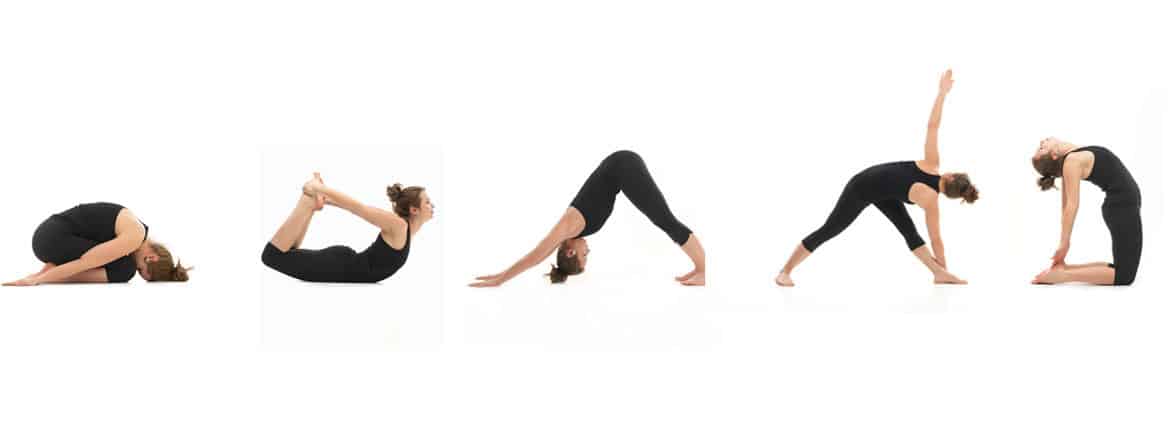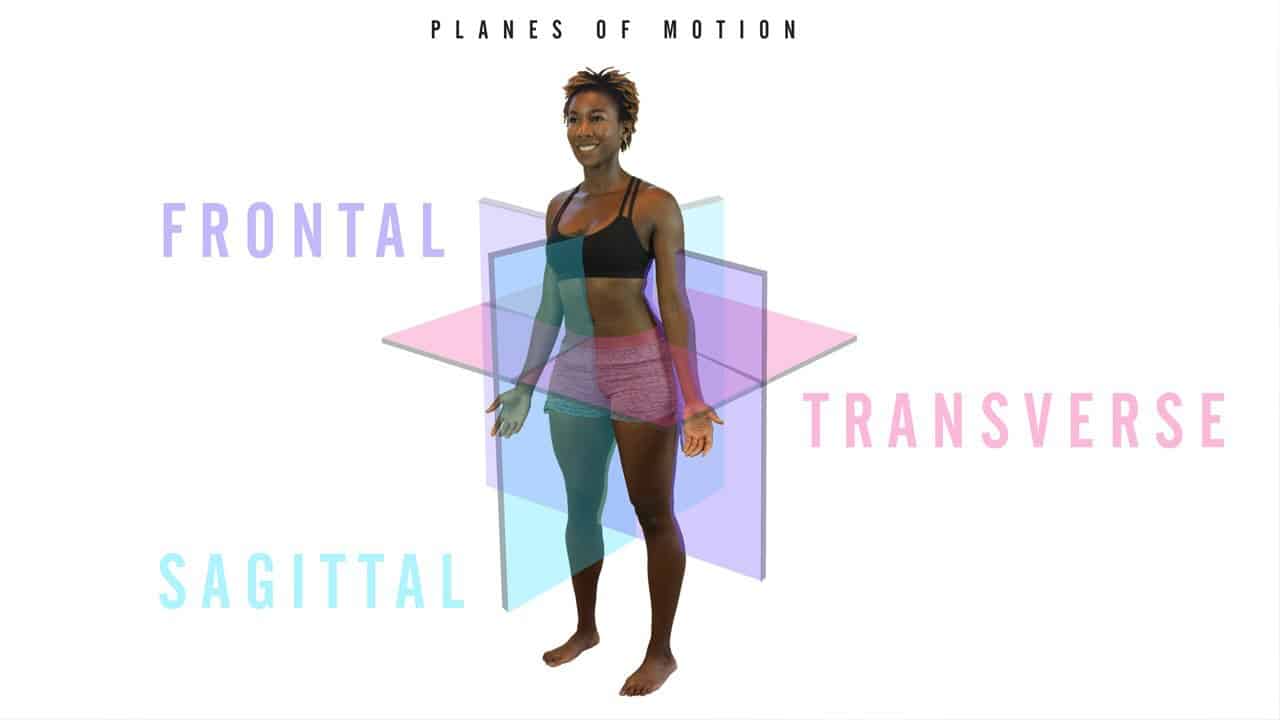Having a flexible body is essential for everyday life, and particularly for exercise. Think of all the things you do throughout your day that cause your muscles to tighten or create discomfort: Being stuck behind a desk, standing for long periods of time, repetitive motions, driving long distances, and exercising without properly maintaining a limber body are all ways that keep you from having a well-balanced and efficient lifestyle. To fully optimize your workout, it is necessary to be flexible in order to perform your exercises properly -- by getting full range of motion in which your joints can potentially move. Here’s why:((Muscle Mechanics, International Sports Sciences Association, “Fitness: The Complete Guide,” page 166)) When we don’t stretch before and after a workout, our muscles hold onto toxins, we risk injury, recovery time takes longer, and our performance is decreased. In order to prevent restrictive mobility, we must do flexibility stretches.((Flexibility Training, International Sports Sciences Association, “Fitness: The Complete Guide,” page 343)) Common areas that need stretching and/or flexibility are the hips, back, knees, and ankles. In this article, you will see why it is not only important to stretch, but to balance the planes of motion in which our body parts move.


from Lifehack - Feed http://bit.ly/2rVI661
How To Stretch
Done consistently, the following flexibility stretches will enhance your workout, you will gain greater range of motion, improve balance, and recover more quickly for your next workout. Typically, a static stretch should be held for 20-60 seconds (International Sports Sciences Association), remembering not to overstretch which can cause injury as overstretching can cause pulled muscles and tears. In a comfortable stretch, you should feel just a slight pull without going beyond normal range of motion. Always be aware of your breathing during a stretch. For example, if you are doing a flexibility movement for the knee, just before you go into the stretch, take a deep breath and then exhale once you are into the stretch. Breathing is important as it relaxes the muscles and helps to loosen them. Your body should be warm before stretching to increase blood flow. This can be a 3-minute ride on a stationary bike or slowly-controlled, 45-60 second body weight squats.Hips Stretches
The hips tend to give us trouble when we get into our 40’s and 50’s, and the cause of pain is not always injury or over-use, but rather, lack of stretching in the hip flexor muscles. Even if you’re not a sedentary person, you walk throughout your work day, climb stairs, or stand for long periods of time, you must keep your hips flexible to keep them from tightening which can cause other problems, like lower back pain. (Everything is connected.) Oftentimes, people who are active tend to think that because they cycle, run, or perform other exercises that recruit the hip flexors, they don’t need to stretch because their hips are constantly moving; Not so. What people don’t recognize is that over time these and other movements create muscle imbalances, spasms, and affect posture. When your hips are flexible, the exercises that recruit gluteal muscles, like the squat and lunge, have better control. Take a look at these 4 hip flexor stretches by Guerilla Zen Fitness: https://www.youtube.com/watch?v=l3caDsbWMxw&feature=youtu.beBack/Spine Stretches
The back and abdominal muscles support the core and are necessary to have a strong gait. In order to have a strong back, you must open up your chest and sides of your back with various stretches. Sometimes, without noticing it, we rely on our back for a variety of movements, such as looking over our shoulder to pass safely in our vehicle, rising up from a chair, reaching up high for an object, etc. These passive movements seem easy, but without a stable core, you’re left with a weak spine and the movements can become challenging over time. Having a flexible spine and strong core is great for exercises like crunches, torso circles, side bends, lying leg raises, and sit-ups. Here are 3 spinal flexibility stretches by Strength Side: https://www.youtube.com/watch?v=jNzqIiLqCxo&feature=youtu.be You can also incorporate regular yoga practice into your daily routine as a holistic approach to gaining flexibility in your back. One of my favorite things about yoga is that it moves energy throughout the entire body, with special attention to the spine. In addition, yoga helps to lengthen muscles and opens up the space between the ribs and vertebrae, which minimizes tension and reduces headaches and backaches.((Top Fuel Crossfit: Yoga Poses to Relieve Headaches: Lengthening the Spine)) Try these yoga poses that are not only good for flexibility but for overall relaxation. Hold each pose for 10 to 15 breaths:((Rukmani Iyengar: 5 Yoga Asanas to Reduce Back Pain))
Knees Stretches
The use of our legs to walk, run, swim or do any the movement that involves the legs also involves the knees. Flexibility in and around the knee joints is essential for mobility, and because everything is connected, flexibility in the knees will also create flexibility in other areas, such as the ankles, which will I will address next. So, if the exercises you perform on machines, such as the leg extension or leg curl, which move in the sagittal plane - that is, forward and backward or up and down - are among your go-to’s when training your lower body, you must have flexible knees. Here are 3 knee strengthening examples by Strength Side: https://www.youtube.com/watch?v=6OMAuda4dGs&feature=youtu.beAnkles Exercises
Ankles run into all kinds of problems, like walking, wearing high heels or uncomfortable shoes, flat feet, trauma, improper footing when performing exercises, arthritis, and even swimming. All of these can cause tendonitis - The inflammation surrounding tendons in the lower leg muscles. Despite what it may look like, the foot does not remain in the same position during up-and-down movements which is why it is important to maintain flexibility in the muscles surrounding the ankle joint. Flexibility allows for various positions (International Sports Sciences Association). In addition to the following exercises, R.I.C.E. (Rest, Ice, Compression, Elevation) is also effective for relieving ankle pain. Here are some examples of how to increase ankle and foot mobility: https://www.youtube.com/watch?v=apCIhoPmHW8&feature=youtu.bePlanes of Motion
Balancing your body’s planes of motion is necessary, not only for weight training and other exercise, but for gaining flexibility as well. Our body is a powerhouse because it is not limited to a single plan of motion movement, and instead has the ability to move in multiple directions - Sagittal, frontal, and transverse. For example, when doing flexibility exercises for your back, you should also work our abdominal muscles. Similarly, when weight-training your quadriceps, you should balance them by also training your hamstrings. This creates balance, coordination, and functionality:((Kai Simon: How To Improve Your Workout: Planes Of Motion))
Bonus Tip
Keep in mind that stretching can go hand-in-hand with the use of sports medicine equipment, such as a foam roller to pre-condition tight muscles and break up lactic acid, compression apparel to maintain warmth, and even a lacrosse ball to target trigger points.((Flexibility Training, International Sports Sciences Association, “Fitness: The Complete Guide,” page 343.)) Now that you are familiar with stretches where common injuries occur, you should experience relief in multiple areas of your body and in your daily life. Tension, stress, and tight muscles can now be curtailed by effective stretching before and after your activities, and your muscles will be more relaxed and efficient, thereby increasing your performance.More Resources About Stretching Exercises
- 15 Simple And Quick Office Stretches To Boost Work Efficiency
- Simple Stretching for Lower Back Pain that You Can Do At Home
- These 13 Leg Stretches Will Prevent Pain and Injury During Exercise
- 4 Simple Desk-Based Stretches For Effective Lower Back Pain Relief
- 15 Important Benefits of Stretching Before, After, and During a Workout
from Lifehack - Feed http://bit.ly/2rVI661
